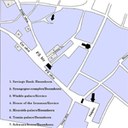0181 The Works of Budapest Architects Lipót Baumhorn and Károly Kovács in Novi Sad at the Turn of the Century
New Findings on the Building History
Identifiers (Article)
Identifiers (Files)
Abstract
Designer of the new synagogue building complex in Novi Sad at the beginning of the 20th century, Lipót Baumhorn (1860–1932) exercised a significant influence on the architecture of the city (then part of the Austro-Hungarian monarchy and today second largest city of Serbia). Apart from the synagogue, the Budapest-based architect created five more buildings in Novi Sad: the bank building in the main square, the highly representative palaces of a local furniture maker and a wine trader, and a small two-storey town house. In addition, the research I conducted in the local archives has revealed the address and fundamental details of one more Baumhorn building, considered up to now to have been demolished; this archival information was inaccessible to local researchers for language reasons.
The purpose of this study is to provide a short introduction to the works of Baumhorn – known for his synagogues only – as well as of a direct colleague of his, Károly Kovács, foreman of the new synagogue complex. I find it crucial to recognize these buildings less for their stylistic features – characterizing the turn of the century – than for the role they play in the urban context, both from a typological and a social perspective.
Statistics


License

This work is licensed under a Creative Commons Attribution-NonCommercial-NoDerivatives 4.0 International License.



